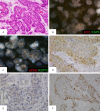Semi-comprehensive analysis of gene amplification in thymic malignant tumors using multiplex ligation-dependent probe amplification and fluorescence in situ hybridization
- PMID: 32509076
- PMCID: PMC7270679
Semi-comprehensive analysis of gene amplification in thymic malignant tumors using multiplex ligation-dependent probe amplification and fluorescence in situ hybridization
Abstract
Research on the amplification of oncogenes in thymic malignant tumor is limited. In this study, we aimed to determine the gene amplification status of receptor tyrosine kinases and other cell regulator genes in thymic malignant tumors, with a view toward the future introduction of molecular targeted therapy. In addition, we examined the usefulness of multiplex, ligation-dependent probe amplification (MLPA) in the semi-comprehensive detection of these gene amplifications. The participants of this study were nine patients with thymic carcinoma and one patient with atypical carcinoid who underwent resection at our department from 1999 to 2016. Twenty-four oncogenes (MDM4, MYCN, ALK, PDGFRA, KIT, KDR, DHFR, EGFR, MET, SMO, BRAF, FGFR1, MYC, ABL1, RET, CCND1, CCND2, CDK4, MDM2, AURKB, ERBB2, TOP2A, AURKA, AR) were analyzed for amplification by MLPA. In cases where amplification by MLPA was suspected, confirmation was performed by fluorescence in situ hybridization (FISH). Immunostaining for detected oncoproteins and p53 were performed in cases with confirmed oncogene amplification. MYC (2/10, 20%) and MDM2 (1/10, 10%) amplifications were detected using MLPA and FISH. Immunostaining in both cases was positive. The MDM2-amplified tumor relapsed and spread rapidly after operation despite the use of post-operative chemo-radiotherapy. MYC amplification may be involved in the carcinogenesis of thymic malignant tumors. In addition, MDM2 amplification may be a concern in the increased malignancy.
Keywords: MDM2; MYC; Thymic carcinoma; fluorescence in situ hybridization; gene amplification; multiplex ligation-dependent probe amplification.
IJCEP Copyright © 2020.
Conflict of interest statement
None.
Figures


Similar articles
-
Copy number analysis of 24 oncogenes: MDM4 identified as a putative marker for low recurrence risk in non muscle invasive bladder cancer.Int J Mol Sci. 2014 Jul 14;15(7):12458-68. doi: 10.3390/ijms150712458. Int J Mol Sci. 2014. PMID: 25026175 Free PMC article.
-
Detection of MDM2/CDK4 amplification in lipomatous soft tissue tumors from formalin-fixed, paraffin-embedded tissue: comparison of multiplex ligation-dependent probe amplification (MLPA) and fluorescence in situ hybridization (FISH).Appl Immunohistochem Mol Morphol. 2015 Feb;23(2):126-33. doi: 10.1097/PDM.0000000000000041. Appl Immunohistochem Mol Morphol. 2015. PMID: 25679065
-
Intratumoral heterogeneous amplification of ERBB2 and subclonal genetic diversity in gastric cancers revealed by multiple ligation-dependent probe amplification and fluorescence in situ hybridization.Hum Pathol. 2014 Apr;45(4):725-34. doi: 10.1016/j.humpath.2013.11.004. Epub 2013 Nov 15. Hum Pathol. 2014. PMID: 24491355
-
Semi-comprehensive analysis of gene amplification in gastric cancers using multiplex ligation-dependent probe amplification and fluorescence in situ hybridization.Mod Pathol. 2015 Jun;28(6):861-71. doi: 10.1038/modpathol.2015.33. Epub 2015 Mar 6. Mod Pathol. 2015. PMID: 25743022
-
Impact of Amplified Oncogenes on Salivary Gland Carcinomas.Cancer Diagn Progn. 2023 Sep 3;3(5):528-532. doi: 10.21873/cdp.10250. eCollection 2023 Sep-Oct. Cancer Diagn Progn. 2023. PMID: 37671310 Free PMC article. Review.
References
-
- Scorsetti M, Leo F, Trama A, D’Angelillo R, Serpico D, Macerelli M, Zucali P, Gatta G, Garassino MC. Thymoma and thymic carcinomas. Crit Rev Oncol Hematol. 2016;99:332–350. - PubMed
-
- Weissferdt A, Moran CA. Thymic carcinoma, part 1: a clinicopathological and immunohistochemical study of 65 cases. Am J Clin Pathol. 2012;138:103–114. - PubMed
-
- Ahmad U, Yao X, Detterbeck F, Huang J, Antonicelli A, Filosso PL, Ruffini E, Travis W, Jones DR, Zhan Y, Lucchi M, Rimner A. Thymic carcinoma outcomes and prognosis: results of an international analysis. J Thorac Cardiovasc Surg. 2015;149:95–100. - PubMed
-
- Hishida T, Nomura S, Yano M, Asamura H, Yamashita M, Ohde Y, Kondo K, Date H, Okumura M, Nagai K Japanese Association for Research on the Thymus (JART) Long-term outcome and prognostic factors of surgically treated thymic carcinoma: results of 306 cases from a Japanese Nationwide database study. Eur J Cardiothorac Surg. 2016;49:835–841. - PubMed
-
- Weksler B, Dhupar R, Parikh V, Nason KS, Pennathur A, Ferson PF. Thymic carcinoma: a multivariate analysis of factors predictive of survival in 290 patients. Ann Thorac Surg. 2013;95:299–303. - PubMed
LinkOut - more resources
Full Text Sources
Research Materials
Miscellaneous
